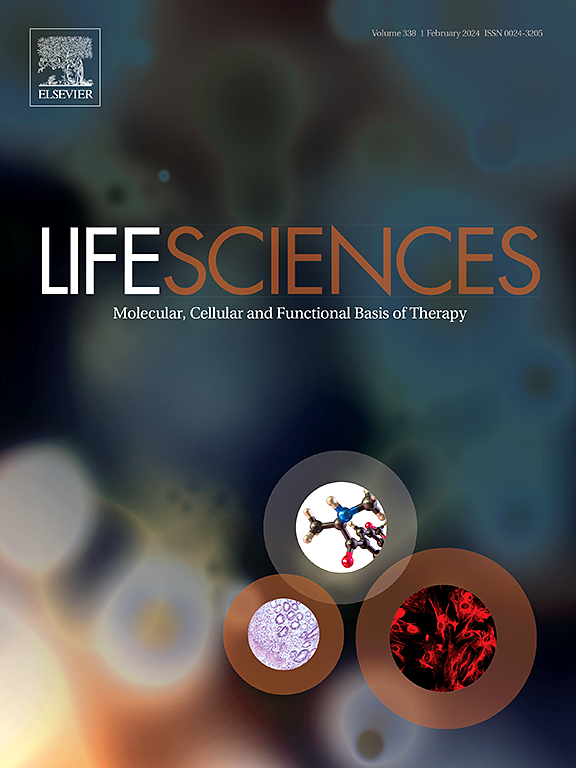CLEC14A 可促进血管生成,减轻糖尿病伤口愈合过程中的炎症反应。
IF 5.2
2区 医学
Q1 MEDICINE, RESEARCH & EXPERIMENTAL
引用次数: 0
摘要
背景:伤口延迟愈合是糖尿病伤口的严重并发症,给糖尿病患者的治疗带来了巨大挑战。糖尿病伤口愈合是一个复杂的动态过程,涉及血管生成和炎症反应。目前,促进糖尿病伤口愈合的靶向疗法非常有限。本研究旨在揭示 CLEC14A 在糖尿病伤口愈合过程中的作用,希望能找到新的治疗靶点,加速糖尿病伤口的愈合:在体内,糖尿病小鼠由链脲佐菌素(STZ)和高脂饮食联合治疗产生。在野生型和 Clec14a-/- 型糖尿病小鼠中建立伤口愈合模型。通过苏木精和伊红(H&E)染色、免疫组化染色和免疫荧光染色评估伤口愈合程度以及愈合过程中的血管生成和炎症反应。在体外,使用划痕试验和血管形成试验评估了人脐静脉内皮细胞(HUVECs)在接受高糖和过表达 CLEC14A 的腺病毒处理后的血管生成活性。白细胞介素-1β(IL-1β)和肿瘤坏死因子-α(TNF-α)用于评估 HUVECs 的炎症水平:结果:CLEC14A在糖尿病伤口中的表达受到抑制。结果:CLEC14A 在糖尿病伤口中的表达受到抑制,Clec14a 的缺失抑制了血管生成并激活了体内的炎症反应。高糖处理导致体外 CLEC14A 表达减少、血管生成能力受损和炎症水平升高。然而,腺病毒介导的 CLEC14A 过表达可逆转高糖诱导的反应:结论:CLEC14A 可通过促进血管生成和减轻伤口炎症反应加速糖尿病伤口愈合。本文章由计算机程序翻译,如有差异,请以英文原文为准。
CLEC14A facilitates angiogenesis and alleviates inflammation in diabetic wound healing
Background
Delayed wound healing is a serious complication of diabetic wounds, posing a significant challenge to the treatment of patients with diabetes. Diabetic wound healing is a complex dynamic process involving angiogenesis and inflammatory responses. Currently, there are limited targeted therapies to promote diabetic wound healing. This study aimed to reveal the role of CLEC14A in the process of diabetic wound healing, with the hope of identifying new therapeutic targets to accelerate the healing of diabetic wounds.
Methods
In vivo, diabetic mice were generated by combined streptozotocin (STZ) and high-fat diet treatment. The wound healing model was established in wild-type and Clec14a−/− diabetic mice. The degree of wound healing, as well as angiogenesis and inflammation during the healing process, were evaluated through Hematoxylin and Eosin (H&E) staining, immunohistochemical staining, and immunofluorescence staining. In vitro, the angiogenic activities of Human Umbilical Vein Endothelial Cells (HUVECs) were assessed following treatment with high glucose and adenoviruses overexpressing CLEC14A, using scratch assays and tube formation assays. Interleukin-1β (IL-1β) and Tumor Necrosis Factor-α (TNF-α) were utilized to evaluate the levels of inflammation in HUVECs.
Results
CLEC14A expression was suppressed in diabetic wounds. Deletion of the Clec14a inhibited angiogenesis and activated inflammatory responses in vivo. High-glucose treatment led to decreased CLEC14A expression, impaired angiogenic capacity, and elevated inflammatory levels in vitro. However, adenoviral-mediated overexpression of CLEC14A reversed the response induced by high glucose.
Conclusion
CLEC14A accelerates diabetic wound healing by promoting angiogenesis and reducing wound inflammation.
求助全文
通过发布文献求助,成功后即可免费获取论文全文。
去求助
来源期刊

Life sciences
医学-药学
CiteScore
12.20
自引率
1.60%
发文量
841
审稿时长
6 months
期刊介绍:
Life Sciences is an international journal publishing articles that emphasize the molecular, cellular, and functional basis of therapy. The journal emphasizes the understanding of mechanism that is relevant to all aspects of human disease and translation to patients. All articles are rigorously reviewed.
The Journal favors publication of full-length papers where modern scientific technologies are used to explain molecular, cellular and physiological mechanisms. Articles that merely report observations are rarely accepted. Recommendations from the Declaration of Helsinki or NIH guidelines for care and use of laboratory animals must be adhered to. Articles should be written at a level accessible to readers who are non-specialists in the topic of the article themselves, but who are interested in the research. The Journal welcomes reviews on topics of wide interest to investigators in the life sciences. We particularly encourage submission of brief, focused reviews containing high-quality artwork and require the use of mechanistic summary diagrams.
 求助内容:
求助内容: 应助结果提醒方式:
应助结果提醒方式:


